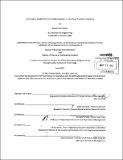Inventory redistribution optimization in the fast fashion industry
Author(s)
Kelley, Rachel Avril
DownloadFull printable version (10.21Mb)
Other Contributors
Leaders for Global Operations Program.
Advisor
Josef Oehmen and Georgia Perakis.
Terms of use
Metadata
Show full item recordAbstract
Zara is the world's leader in the fast-fashion industry and introduces over 10,000 unique designs to their stores each year. Zara's parent company, Inditex, reported profits of $2.2 billion in 2012, an increase of 27% for the year. They opened 360 new stores in over 50 markets across all of their brands last year. Zara contributes approximately 60% of these profits and has around 1,720 stores in over 80 countries worldwide. Zara is committed to meeting the needs of their customer through continuous improvement of their processes and systems. Though they continually improve their already advanced forecasting and distribution methods, there is significant variability in demand that remains challenging to predict. Due to this uncertainty in demand and the short life cycle of trendy clothing articles, it is imperative that Zara is able to quickly respond to changing demand patterns. After initial distribution, inventory can be redistributed among stores in order to satisfy their customers' demand and maximize sales. This critical step in the distribution process is known as inventory transfers. The purpose of this project was to develop a demand forecast model, optimization model and operational process to optimize and standardize these inventory transfers among the complex network of thousands of Zara stores. The key performance indicator was an increase in profit of at least three percent. The research process was first to identify the key decision-making criteria and variables affecting transfer decisions; second to use that criteria to build an optimization model to propose optimal redistribution of articles among stores; and third to prepare the roll-out and integration of the new approach in the existing operational process and IT system. This project required integration with Zara stakeholders across many functions including product management, buying, distribution and information technology. Crucial to the success of the project was remaining focused on these stakeholder needs to ensure the model would be easily adopted and fully implemented while also considering demand, costs, logistics, feasibility and many other factors. The new model provides a profit increase of 21 percent for those articles transferred and is the first model of this kind applied in retail supply chain management.
Description
Thesis (M.B.A.)--Massachusetts Institute of Technology, Sloan School of Management; and, (S.M.)--Massachusetts Institute of Technology, Engineering Systems Division; in conjunction with the Leaders for Global Operations Program at MIT, 2013. Cataloged from PDF version of thesis. Includes bibliographical references (p. 100).
Date issued
2013Department
Leaders for Global Operations Program at MIT; Massachusetts Institute of Technology. Engineering Systems Division; Sloan School of ManagementPublisher
Massachusetts Institute of Technology
Keywords
Sloan School of Management., Engineering Systems Division., Leaders for Global Operations Program.